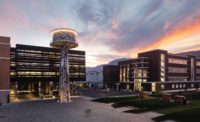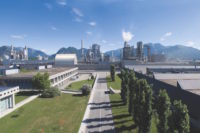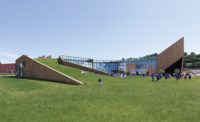In Tuscany, they tell you, wine is close to being a religion. If so, the 600-year-old winemaking dynasty of Antinori is an oenological priesthood, the current high priest being the Marchese Piero Antinori, widely regarded as a hero of the post'World War II Italian wine industry. His company developed the luscious, long-lived wines called Super Tuscans, which challenged both archaic Italian winemaking laws and the finest wines of Bordeaux. Now the Antinori descendants have gone right back to their roots, building a new winery and headquarters among the hilly vineyards of the Chianti Classico region outside their ancestral home of Florence. For all the family history, there is nothing remotely traditional about this earth-sheltered building.
Designed by Archea Associati, a Florence-based firm with offices around the world, the new Antinori HQ is just outside the village of Bargino. It is a building that is simultaneously industrial (a winery is, after all, a factory with warehousing), a visitor destination complete with museum and restaurant, and an office housing 120 people, including senior Antinori family members. The public face and administration area are at the front, factory functions are set higher at the back, and a sequence of wine vaults dug into the slope links the two.
The complex is large by European standards. Excluding landscape, it is some 550 feet long by nearly 500 feet deep on a staggered section, and 60 feet tall in total, arranged over four interlocking levels. Despite this, there is no visible bulk and little by way of elevations. Using a selective palette of materials in harmony with the color of the soil, the architects worked with the idea that it should appear from a distance as no more than a couple of horizontal slashes in the terrain. Some costly engineering was needed to achieve this. When excavation began in 2005 the land turned out to be unstable, requiring extensive piling and horizontal ground anchors. Made mainly of poured-in-place concrete, the building boasts a curvilinear steel canopy along the main terrace with a very deep cantilever, an especially formidable feat considering the weight of soil on top.
Now complete after a slow and difficult build, this 'earth ship' is successfully merging with its surroundings, though it will take another season before the hillside, still raw in places, fully greens up. The profile of the excavated ground'a roughly rectangular, steeply sloping 35-acre site that resembled a quarry during construction'has been restored. Vines are planted over the building, olive trees above and behind it. From the road below, you are aware only of a retaining wall in reddish concrete with the company's name and crest emblazoned on it. At this point a driveway'quite large, to take trucks'snakes up the hillside, disappears beneath the building, and deposits you either at a drop-off point beneath the main terrace or in a sunken parking lot.
The design is all about gradual disclosure: you catch a glimpse of the Cor-Ten steel cornice of the main terrace as you drive up the approach, only for it to disappear as you move beneath the building. The visitor entrance is the visual fulcrum of the structure, expressed by a virtuoso asymmetric spiral staircase (also Cor-Ten)'sculptural as much as practical, since elevators and more conventional stairs inside provide the main vertical movement. Nearly all finishes throughout are left rough and industrial, whether more of the oxidized steel used for handrails or sawn-oak interior wall surfaces.
Three earth-tone materials dominate: Cor-Ten steel; that reddish concrete (achieved through an iron oxide in the mix); and long terra-cotta bricks, similar in tone to the concrete, used variously for paving, soffit cladding, and walls. In the wine-storage vaults they wrap right around the interiors.
Although principally a single-aspect building, facing west across a valley, the structure was designed to bring in daylight both from above'through numerous circular apertures in the covering landscape'and more unexpectedly from the rear, where a service road for trucks and employee parking is terraced high into the slope. This part of the facility is wholly for the winemaking process, from the arrival of grapes for crushing through fermentation, barrel aging, bottling, bottle aging, and eventual packaging and dispatch. Visitor tours include the Antinori museum, complete with a Renaissance-era geared double wine press designed by Leonardo da Vinci; tasting rooms, some of which project into the barrel vaults in the form of glazed boxes: a promenade along a high-level walkway traversing the vaults; a small restaurant perched on the main terrace looking out across the valley; and, of course, the shop, where the company's products are displayed in terra-cotta shelving units designed by the architects.
Since the cellars are a key part of the tour, they were conceived in dramatic fashion to be cavelike. Rather than being regularly arched, they form a sinusoidal sequence on a steel frame, built within a much larger concrete rectilinear space. The frame was then lined with the terra-cotta bricks, slid onto concealed metal rail fittings. In these vaults the oak barriques, or small barrels, associated with the best wines are stacked in rows. Less exalted wines are matured in larger barrels, some very large indeed. Perhaps most impressive of all are the tall stainless steel fermentation tanks, but few members of the public are allowed to see those overtly industrial objects. Seen or unseen, however, all enjoy the constant cool temperature that wine needs to mature, as a natural consequence of being sunk into the hillside.
Archea's cofounder, architect Marco Casamonti, talks of 'a contemplative relationship with, rather than an emulation of, the natural landscape.' The project implies a kind of equilibrium with nature, and takes a manifesto position: yes, a large manufacturing complex such as this can harmonize with a rural area.
The time and effort that have gone into this building are palpable. But as one of the key movers in the ancestral business, Piero's elder daughter, Albiera, pointed out as we talked in their Renaissance palazzo in Florence: 'Obviously the new building is very innovative. But this house has been the center of activity for us since 1506. It too was designed in a way that was modern for its time. It still works exactly as it did 500 years ago. It was looking forward, not back.' Plainly, the 26th generation of the Antinori family has lost none of its perfectionist zeal.
Hugh Pearman is architecture critic of the Sunday Times of London and editor of the Journal of the Royal Institute of British Architects.
Size: 527,400 square feet
Cost: $111.2 million
Completion date: October 2012
PeopleOwner: Marchesi Antinori S.r.l.
Location: San Casciano Val di Pesa, Italy
Architect: Archea Associati Personnel in architect's firm who should receive special credit:
Engineer(s): HYDEA
Consultant(s): Structural: AEI Progetti Landscape: M&E Management & Engineering (design); Emex Engineering (oenological)
General contractor: Inso |
ProductsStructural system Steel: Secco Sistemi (Corten) Concrete: CSP (prefabricated) Formwork: ALPI Glazing Pilkington, Sunglass (curved) MPA (glass) Interior finishes Acoustical surfaces and plasterboard: Knauf Paints and stains: Novocolor Terra cotta: Sannini Impruneta, Ceipo Ceramiche (furniture elements) Adhesivies: MAPEI Carpet: Besana Raised floor: Teknofloor Furnishings Office furniture: Estel Furniture: Moroso (furniture, chairs, sofas), Castelli (chairs) Lighting Zumtobel, Martini Illuminazione Conveyance Elevators/Escalators: Kone |
















Post a comment to this article
Report Abusive Comment